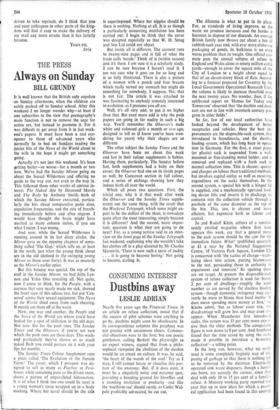Dustbins away
CONSUMING INTEREST LESLIE ADRIAN
Nearly five years ago the Financial Times, in an article on refuse collection, noted that if the success of pilot schemes were anything to go by, dustbins might soon be obsolescent. In its correspondence columns this prophecy was not greeted with unanimous cheers. Commer- cial objections were to the fore; but one poetic gentleman, calling Beckett the playwright as an expert witness, argued that from a philo- sophical viewpoint the abolition of the dustbin would be an attack on culture. It Was, he said, 'the heart of the womb of the soul.' Try as I may, I still cannot locate or visualise this por- tion of the anatomy. But, if it does exist, it must be a singularly noisy and noisome spot, providing a breeding ground for blowflies and a standing invitation to predacity—and like the 'nuciform sac' should surely, as Cutler Wal- pole profitably advocated, be cut out. The dilemma is what to put in its place. Bk., as standards of living improve, so the waste we produce increases and the harder it becomes to dispose of our discards. An average British family now throws out about a ton of rubbish each year and, with ever more elaborate packaging of goods, its bulkiness is an even worse problem than its weight. One official esti- mate puts the annual volume of refuse in England and Wales alone at ninety million cubic yards—enough to cover the .iquare_mile of the City of London to a height about equal to that of an eleven-storey block of flats. Accord- ing to a forecast prepared for Coventry by the Local Government Operational Research Unit, the volume is likely to increase threefold over the next twenty years. No wonder, then, if the celebrated report on 'Homes for Today and Tomorrow' observbd that 'the dustbin and dust- cart are not in line with twentieth century pro- gress in other fields.'
So far, few of our local authorities have looked beyond the development of better receptacles and vehicles. Here the best im- provements are the disposable-sack system, first introduced in Scandinavia, and the dustless loading system, which has long been in opera- tion in Germany. For the first, a stout paper (or plastic) sack is suspended from a wall- mounted or free-standing metal holder, and is removed and replaced with a fresh sack at normal collection time. This is cleaner, quieter and cheaper on labour than traditional methods, but involves capital outlay as well as recurring expenditure on the sacks themselves. In the second system, a special bin with a hinged lid is supplied, and a mechanically operated load- ing device lifts and inverts it to discharge its contents into the collection vehicle through a porthole of the same diaineter as the top of the bin. This, too, is cleaner and more efficient, but expensive both in labour and capital.
Jo and Rudolf Klein, editors of a reminis- cently' entitled magazine whose first issue appears this week, say that 'a general move to the sack system should be the aim for the immediate future. What? (Published quarterly at a year by the National Suggestions Centre, 18 Victoria Park Square, London E2) is concerned with 'the tactics of change—trans- lating ideas into action, putting brainwaves to the test, persuading those in authority to experiment and innovate?' Its opening shots are on target. At present the disposable-sack system of refuse collection is used for barely 2 per cent of dwellings—roughly the same number as are served by the dustless loading system—though economic stringency may cur- rently be more to blame than local inertia. 'It does mean spending more money at first,' the Kleins admit, 'but as labour costs rise, this disadvantage will grow less and may even dis- appear. When Manchester first introduced sacks, this system was 33 per cent more expen- sive than the older methods. The comparable figure is now down to 8 per cent. And Southend found that the time saved by using the sacks made it possible to introduce a bi-weekly collection'—a telling point. In the long run, however, what we really need is some completely hygienic way of dis- posing of garbage so that there is nothing left to be removed by the dustman. Electrically operated sink waste disposers, though a luxuri- ous boon, are scarcely the answer, since they deal with only 10 to 15 per cent of a family's refuse. A Ministry working party reported last year that up to now ideas for which a practi- cal application had been found in this country (principally for waterborne removal or on-site incineration) had fallen short of the ideal. But recently a system for conveying refuse from buildings to disposal points by pneumatic sue- non has been working well in Sweden. West- minster City Council, which is planning to adopt it for a new housing development, be- lieves it could do for rubbish 'what main drainage did for the cess cart a century ago.' Unfortunately, most existing residential agglomerations are ill-designed places in which to work such a revolution.







































 Previous page
Previous page